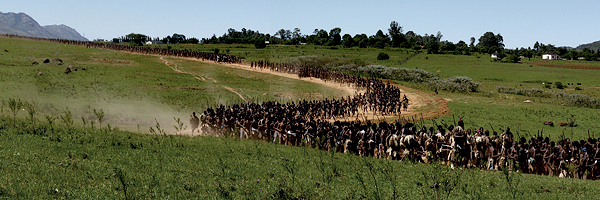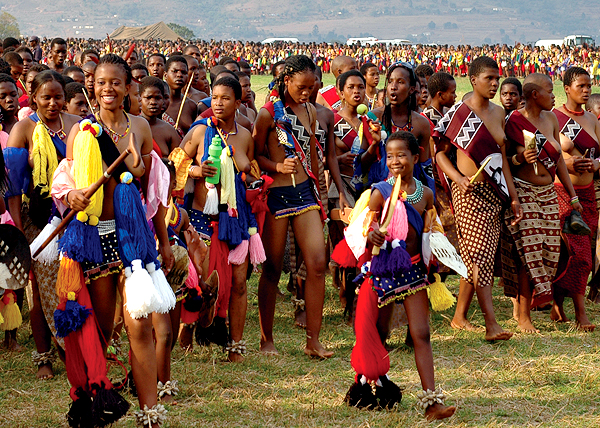
ADVENTURE
AIDS
AIRLINES
AIRPORT
AIRPORT BUS
ARCHAEOLOGY
ARCHITECTURE
ARCHIVES
ART GALLERIES
BANKS
BIRDING
BOOK EXCHANGE
BUDGET TRAVEL
BUSES
BUSHFIRE
BUSHMAN PAINTINGS
BUSHMEN
CAMPSITES
CAR HIRE
CARS and DRIVING
CATTLE
CLIMATE
COLONIALISM
CRIME
DRUGS
ECONOMY
HISTORY
IMMIGRATION
KINGS
MBABANE
NATURE RESERVES
POLICE
RITUAL CEREMONIES
SIBEBE TRAILS
TOUR COMPANIES
TRAVEL AGENCIES
Index to information in the guide
Traditional beliefs, rituals and practices run stronger and deeper in Swaziland than anywhere else in Southern Africa. There are two annual ceremonies that attract large numbers of participants and spectators. These are the Incwala and the Umhlanga or Reed Dance. Once common throughout Southern Africa, such occasions are now really only performed in their entirety in Swaziland.
The Incwala is a sacred ceremony of Kingship and a first fruits ceremony, a mystical rite of powerful spiritual significance for the Nation. The King and the nation are inextricably one and the cleansing and renewal ceremonies performed during the Incwala affect both King and Nation, or at least traditionally minded Swazis who are probably more than half of adults. The Incwala is really a process rather than one ceremony. The process starts at the last new moon of the year.
Runners are sent to the main rivers and to the sea to fetch water and on their return rituals are performed, sacred songs are sung and ritual dances performed. Thousands of young men march 60 kilometers to gather special branches (Dichrostachys cinerea) which are later used to decorate the King's private sanctuary. In it secret parts of the Incwala are performed. Sacred songs (which may not be recorded) are sung while a black ox is put into the shelter and slaughtered. Rituals are performed over the carcass of the bull for the revitalising of the King and his powers. There is a huge celebration in the middle of the ceremony. After alternate days of dancing and meditation the bones of the ox are gathered, a huge fire is lit over them and the ancestral spirits are asked to bring rain to show their favour and acceptance of the rituals performed. Almost always it does rain, usually putting out the fire.

Traditionally the nation does not eat the new harvest until after this occasion. The Incwala is the most sacred annual event; spectators are permitted, but not encouraged. The sacred parts of the ceremony are held in secret and members of the public are not permitted to be present at these times. Tourists are allowed, but you will be told exactly when and where to take your photos. Do not take any outside of these times and places. This is not a re-constructed ceremony, it is the real thing, centuries old.
The Umhlanga, or Reed Dance, is quite different in feeling. Many of the young women who have not yet had children gather together. The girls who may be teenagers or in their early twenties, wear the very colourful traditional costume of the unmarried maiden. They walk long distances to collect reeds and bring them to the Queen Mother. Younger girls do participate, but they are not required to undertake the long march, instead collecting the reeds from rivers close to the royal residence. The final days are visually stunning, with tens of thousands of girls returning to the kraal. A seemingly never-ending line of bare-breasted girls walk, several deep, moving through the veld like a giant, brightly marked snake.
Refreshed after a night's sleep they arrive in the royal enclosure the following morning, dancing, singing and ululating, to deliver their bundles of reeds to the Queen Mother. The King is there and often chooses a potential wife from those present. The dancing varies so that each virgin dances before the King. An extraordinary and beautiful ceremony to many, some feminists find it deeply insulting to womanhood.
When he was at school the ceremony was held in his absence and he reputedly chose a wife from the videotape of the dance. The reeds are used to rebuild the windbreak in front of the Queen Mother's residence and symbolises the loyalty of the maidens. Visitors are welcome to observe this ceremony. Photography is permitted, it needs a permit but nobody is likely to check, as this is not a sacred power ceremony like the Incwala, but a celebration. Get there on time to find a seat and bring plenty of film. A powerful zoom or telephoto lens is a good idea to get detail - this ceremony is spectacular.
